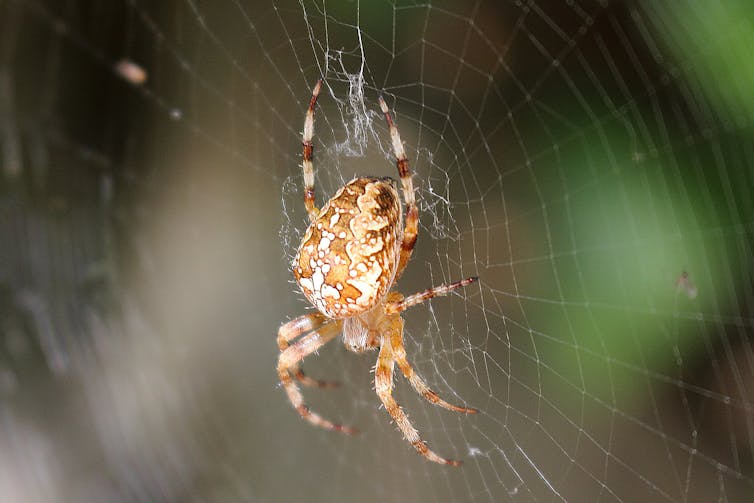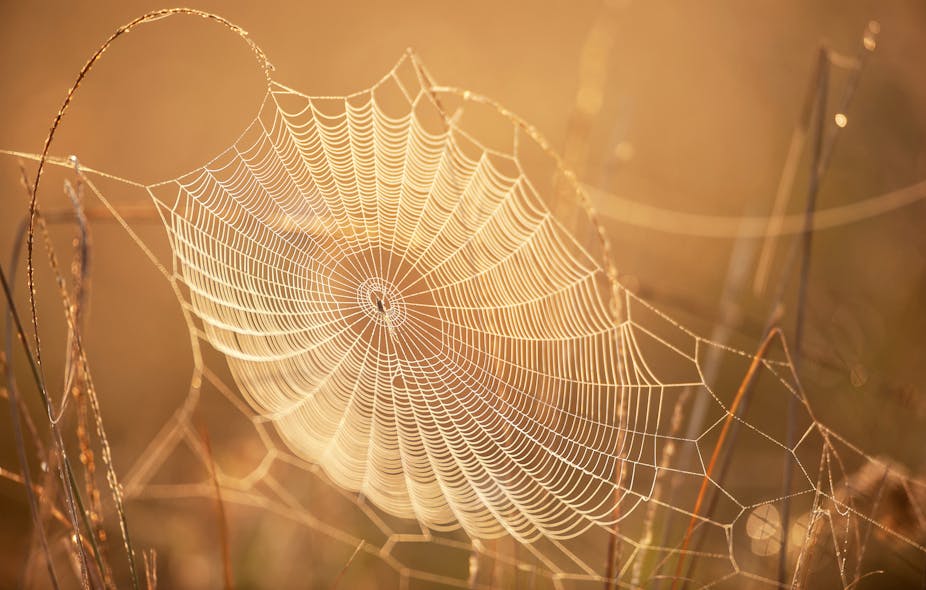
Curious Kids is a series by The Conversation, which gives children of all ages the chance to have their questions about the world answered by experts. All questions are welcome: you or an adult can send them – along with your name, age and town or city where you live – to curiouskids@theconversation.com. We won’t be able to answer every question, but we’ll do our best.
How is spider silk so easy to break when it’s stronger than steel? - George, aged ten, Hethersett, UK.
Thanks for the question, George – the simple answer is that spider silk breaks easily because it’s really, really, really thin. A thread in the web of a garden spider is just 0.003 millimetres across – that’s more than 20 times thinner than a hair from your head.
But there are a few more matters we need to untangle, to see how strong spider silk is, compared with steel.
Steel is a material called an alloy, which means it is a mixture of metals. The main metal in steel is iron. Other metals are added to the iron, depending on what you want the steel to do.
For example, knives and forks are made from stainless steel that doesn’t rust. To make this you’d mix iron and chromium.

But maybe you want a steel that is really strong so you could make buildings and cranes from it. Then, you would need to mix iron with a load of different metals including titanium and vanadium.
But there are even stronger steels. Your bike might be built with something called maraging steel and it’s made with iron, nickel, cobalt, molybdenum, titanium and aluminium.
Spiders’ different silks
Silk is a very different material from steel. It is actually protein – the same stuff that your hair and finger nails are made from.
We use steel for different jobs and spiders use silk for all sorts of things as well. And the just like our steel, spiders need different silks for the different jobs.
Let’s look at the common European garden spider: this lovely creature spins the beautiful round webs, using two types of silk.

The spokes of the web are made from dragline silk. This is strong and slightly stretchy, which means it’s good for making the main supports for the web.
The rest of the web is made from flag silk, which is less strong but very elastic, so it is really good at absorbing the shock when a great big fly smashes into the web.
But the champion constructor of the spider world is the Darwin bark spider. It produces huge webs, about the size of a kitchen table.
These are sometimes hung from trees with silk threads that stretch right across rivers. To make sure these webs stay in place, the spider uses super strong threads of silk.

Now, I’ve done some calculations, based on what scientists know about the strength of these different materials, to compare steels with spider silks and see just how strong they are.
The winning web
Imagine we had a thread of each material, that was about one millimetre thick – that’s roughly the width of a pin head. Who could hang from them before they broke?
The weakest is the flag line silk: a ten-year-old girl could probably swing from a thread of this, but nothing much heavier.
Next comes the high strength steel which would just about be OK if a chimpanzee hung from it.
The dragline silk would support a small adult – like Spiderman.
The Darwin bark spider silk is next, it would break if anything much bigger than a panda tried to climb it.
And finally, a gorilla would be fine dangling from a one millimetre-thick thread of maraging steel.
Which means that some the strongest steel is actually tougher than the champion spider silks. That is a shame, but all is not lost for the spiders: remember, some of their silks are still stronger than some steels.
More Curious Kids articles, written by academic experts:

